Leadership, Management, and Operations in Organisations
VerifiedAdded on 2020/06/06
|13
|4183
|138
Report
AI Summary
This report provides a comprehensive overview of leadership and management within organizations, focusing on the roles of leaders and managers in various situational contexts. It explores several leadership theories and models, including systems leadership, contingency leadership, and situational leadership, highlighting their strengths and weaknesses. The report also examines key approaches to operations management, such as lean production and total quality management, and discusses the importance of operations management in achieving business objectives. Furthermore, it identifies factors within the business environment that impact operational management and decision-making, using Mark & Spencer as a case study to illustrate practical applications of the concepts discussed. Desklib offers a wide range of study tools and resources, including past papers and solved assignments, to support students in their academic endeavors.
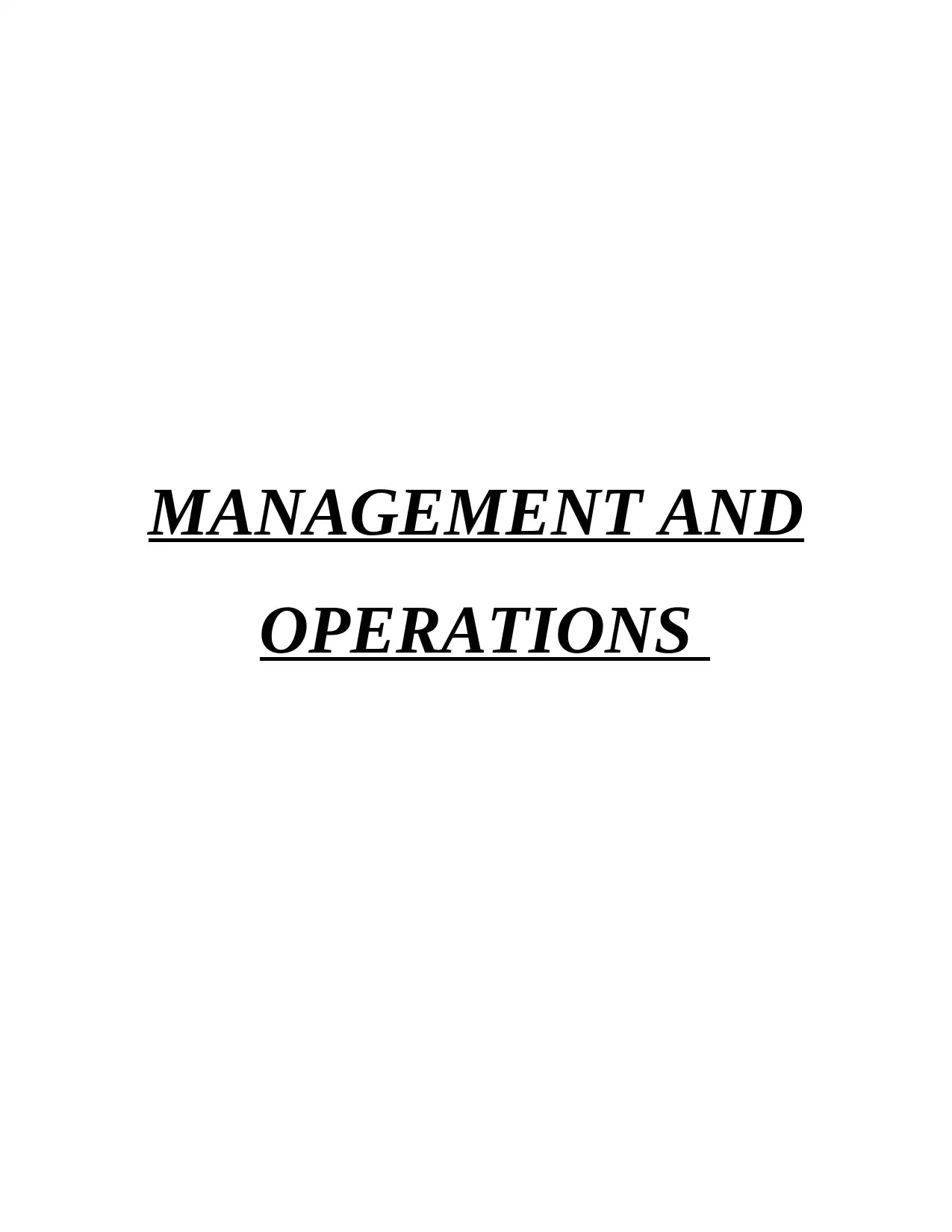
MANAGEMENT AND
OPERATIONS
OPERATIONS
Paraphrase This Document
Need a fresh take? Get an instant paraphrase of this document with our AI Paraphraser
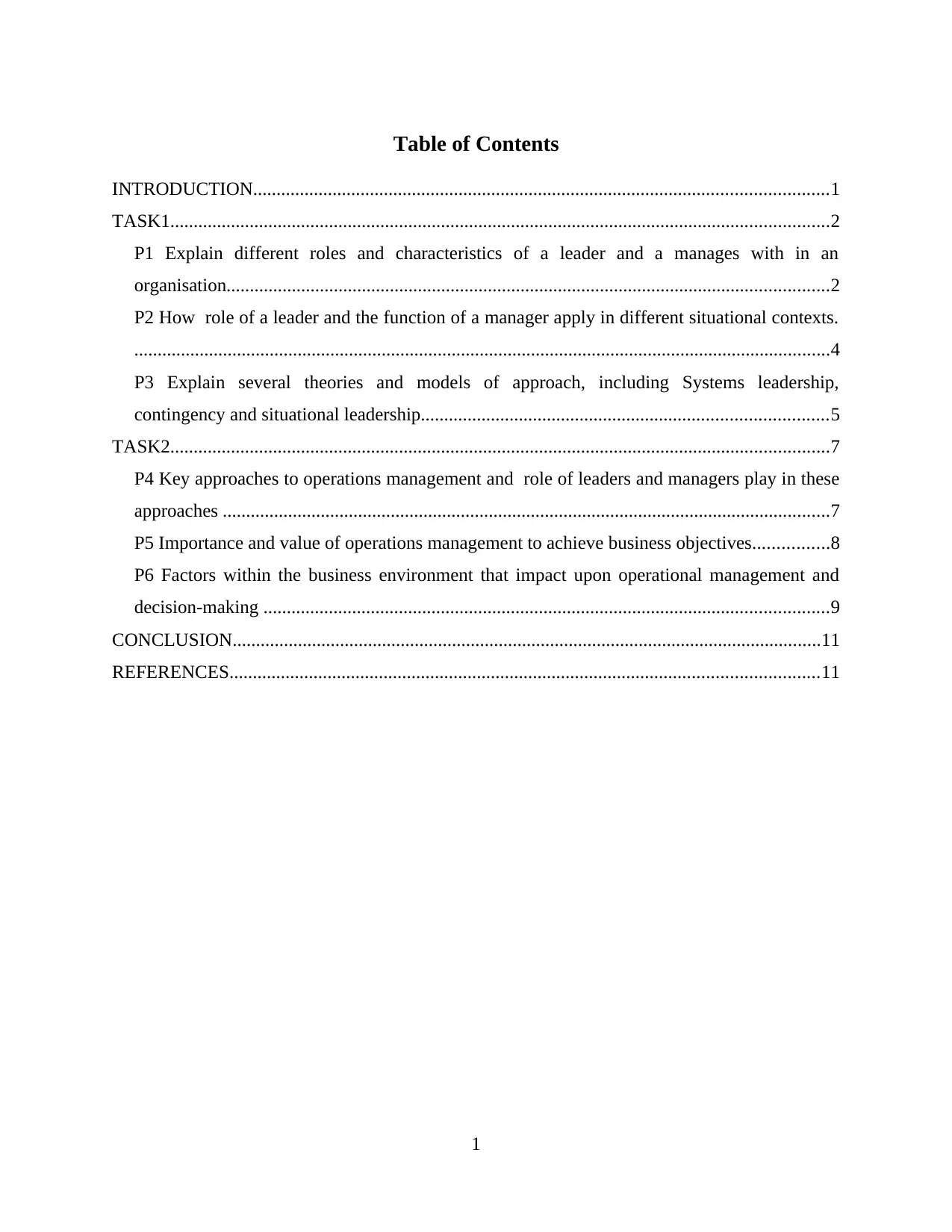
Table of Contents
INTRODUCTION...........................................................................................................................1
TASK1.............................................................................................................................................2
P1 Explain different roles and characteristics of a leader and a manages with in an
organisation.................................................................................................................................2
P2 How role of a leader and the function of a manager apply in different situational contexts.
.....................................................................................................................................................4
P3 Explain several theories and models of approach, including Systems leadership,
contingency and situational leadership.......................................................................................5
TASK2.............................................................................................................................................7
P4 Key approaches to operations management and role of leaders and managers play in these
approaches ..................................................................................................................................7
P5 Importance and value of operations management to achieve business objectives................8
P6 Factors within the business environment that impact upon operational management and
decision-making .........................................................................................................................9
CONCLUSION..............................................................................................................................11
REFERENCES..............................................................................................................................11
1
INTRODUCTION...........................................................................................................................1
TASK1.............................................................................................................................................2
P1 Explain different roles and characteristics of a leader and a manages with in an
organisation.................................................................................................................................2
P2 How role of a leader and the function of a manager apply in different situational contexts.
.....................................................................................................................................................4
P3 Explain several theories and models of approach, including Systems leadership,
contingency and situational leadership.......................................................................................5
TASK2.............................................................................................................................................7
P4 Key approaches to operations management and role of leaders and managers play in these
approaches ..................................................................................................................................7
P5 Importance and value of operations management to achieve business objectives................8
P6 Factors within the business environment that impact upon operational management and
decision-making .........................................................................................................................9
CONCLUSION..............................................................................................................................11
REFERENCES..............................................................................................................................11
1
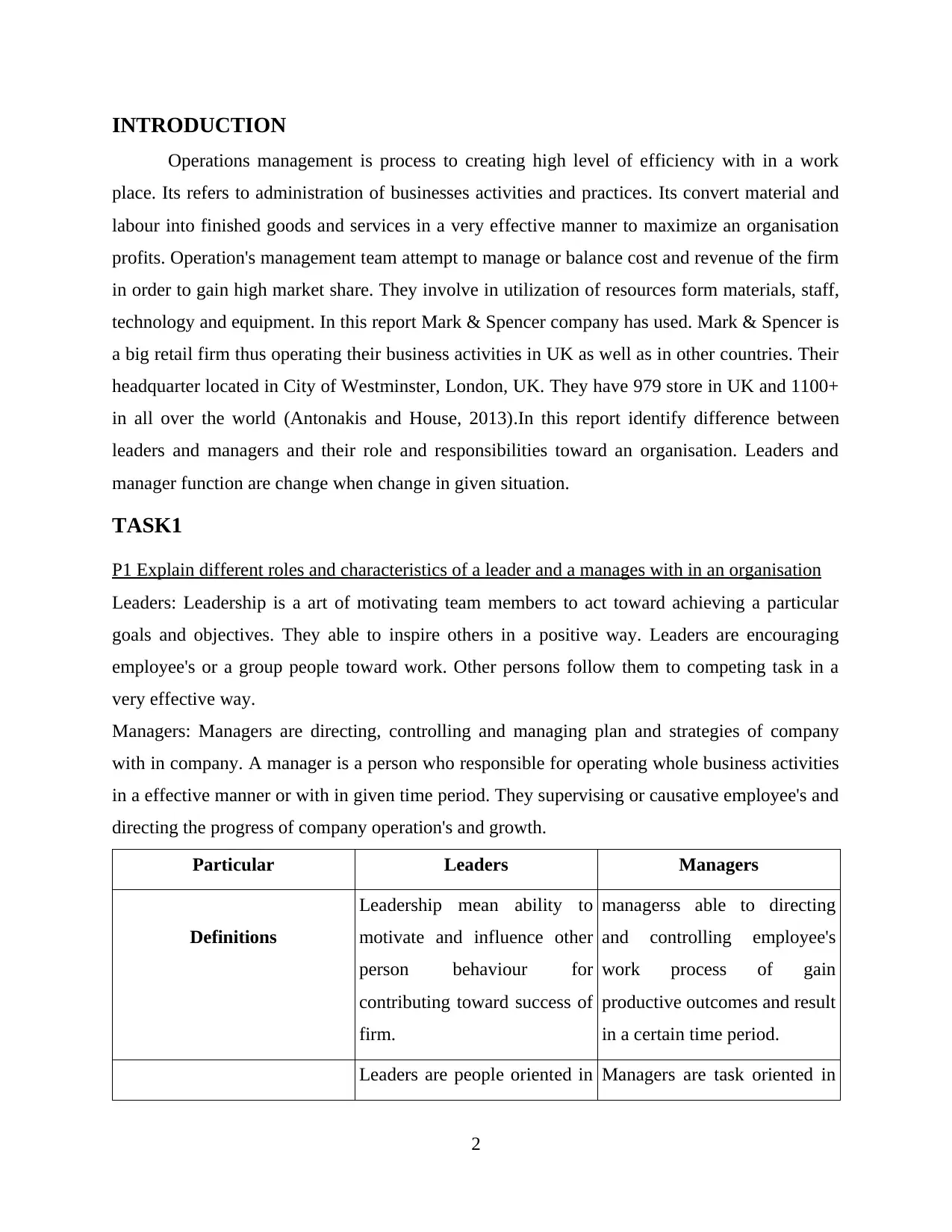
INTRODUCTION
Operations management is process to creating high level of efficiency with in a work
place. Its refers to administration of businesses activities and practices. Its convert material and
labour into finished goods and services in a very effective manner to maximize an organisation
profits. Operation's management team attempt to manage or balance cost and revenue of the firm
in order to gain high market share. They involve in utilization of resources form materials, staff,
technology and equipment. In this report Mark & Spencer company has used. Mark & Spencer is
a big retail firm thus operating their business activities in UK as well as in other countries. Their
headquarter located in City of Westminster, London, UK. They have 979 store in UK and 1100+
in all over the world (Antonakis and House, 2013).In this report identify difference between
leaders and managers and their role and responsibilities toward an organisation. Leaders and
manager function are change when change in given situation.
TASK1
P1 Explain different roles and characteristics of a leader and a manages with in an organisation
Leaders: Leadership is a art of motivating team members to act toward achieving a particular
goals and objectives. They able to inspire others in a positive way. Leaders are encouraging
employee's or a group people toward work. Other persons follow them to competing task in a
very effective way.
Managers: Managers are directing, controlling and managing plan and strategies of company
with in company. A manager is a person who responsible for operating whole business activities
in a effective manner or with in given time period. They supervising or causative employee's and
directing the progress of company operation's and growth.
Particular Leaders Managers
Definitions
Leadership mean ability to
motivate and influence other
person behaviour for
contributing toward success of
firm.
managerss able to directing
and controlling employee's
work process of gain
productive outcomes and result
in a certain time period.
Leaders are people oriented in Managers are task oriented in
2
Operations management is process to creating high level of efficiency with in a work
place. Its refers to administration of businesses activities and practices. Its convert material and
labour into finished goods and services in a very effective manner to maximize an organisation
profits. Operation's management team attempt to manage or balance cost and revenue of the firm
in order to gain high market share. They involve in utilization of resources form materials, staff,
technology and equipment. In this report Mark & Spencer company has used. Mark & Spencer is
a big retail firm thus operating their business activities in UK as well as in other countries. Their
headquarter located in City of Westminster, London, UK. They have 979 store in UK and 1100+
in all over the world (Antonakis and House, 2013).In this report identify difference between
leaders and managers and their role and responsibilities toward an organisation. Leaders and
manager function are change when change in given situation.
TASK1
P1 Explain different roles and characteristics of a leader and a manages with in an organisation
Leaders: Leadership is a art of motivating team members to act toward achieving a particular
goals and objectives. They able to inspire others in a positive way. Leaders are encouraging
employee's or a group people toward work. Other persons follow them to competing task in a
very effective way.
Managers: Managers are directing, controlling and managing plan and strategies of company
with in company. A manager is a person who responsible for operating whole business activities
in a effective manner or with in given time period. They supervising or causative employee's and
directing the progress of company operation's and growth.
Particular Leaders Managers
Definitions
Leadership mean ability to
motivate and influence other
person behaviour for
contributing toward success of
firm.
managerss able to directing
and controlling employee's
work process of gain
productive outcomes and result
in a certain time period.
Leaders are people oriented in Managers are task oriented in
2
⊘ This is a preview!⊘
Do you want full access?
Subscribe today to unlock all pages.

Trusted by 1+ million students worldwide
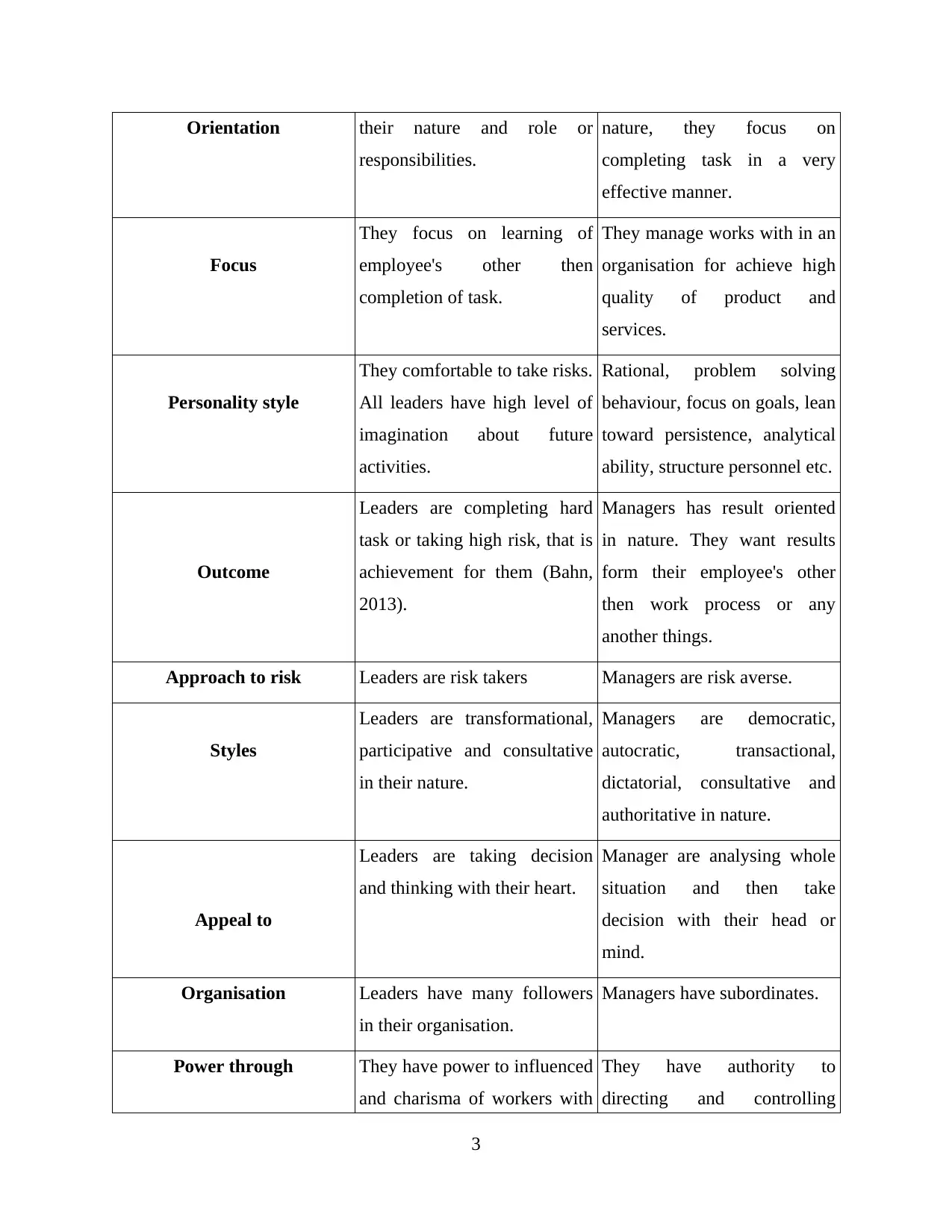
Orientation their nature and role or
responsibilities.
nature, they focus on
completing task in a very
effective manner.
Focus
They focus on learning of
employee's other then
completion of task.
They manage works with in an
organisation for achieve high
quality of product and
services.
Personality style
They comfortable to take risks.
All leaders have high level of
imagination about future
activities.
Rational, problem solving
behaviour, focus on goals, lean
toward persistence, analytical
ability, structure personnel etc.
Outcome
Leaders are completing hard
task or taking high risk, that is
achievement for them (Bahn,
2013).
Managers has result oriented
in nature. They want results
form their employee's other
then work process or any
another things.
Approach to risk Leaders are risk takers Managers are risk averse.
Styles
Leaders are transformational,
participative and consultative
in their nature.
Managers are democratic,
autocratic, transactional,
dictatorial, consultative and
authoritative in nature.
Appeal to
Leaders are taking decision
and thinking with their heart.
Manager are analysing whole
situation and then take
decision with their head or
mind.
Organisation Leaders have many followers
in their organisation.
Managers have subordinates.
Power through They have power to influenced
and charisma of workers with
They have authority to
directing and controlling
3
responsibilities.
nature, they focus on
completing task in a very
effective manner.
Focus
They focus on learning of
employee's other then
completion of task.
They manage works with in an
organisation for achieve high
quality of product and
services.
Personality style
They comfortable to take risks.
All leaders have high level of
imagination about future
activities.
Rational, problem solving
behaviour, focus on goals, lean
toward persistence, analytical
ability, structure personnel etc.
Outcome
Leaders are completing hard
task or taking high risk, that is
achievement for them (Bahn,
2013).
Managers has result oriented
in nature. They want results
form their employee's other
then work process or any
another things.
Approach to risk Leaders are risk takers Managers are risk averse.
Styles
Leaders are transformational,
participative and consultative
in their nature.
Managers are democratic,
autocratic, transactional,
dictatorial, consultative and
authoritative in nature.
Appeal to
Leaders are taking decision
and thinking with their heart.
Manager are analysing whole
situation and then take
decision with their head or
mind.
Organisation Leaders have many followers
in their organisation.
Managers have subordinates.
Power through They have power to influenced
and charisma of workers with
They have authority to
directing and controlling
3
Paraphrase This Document
Need a fresh take? Get an instant paraphrase of this document with our AI Paraphraser
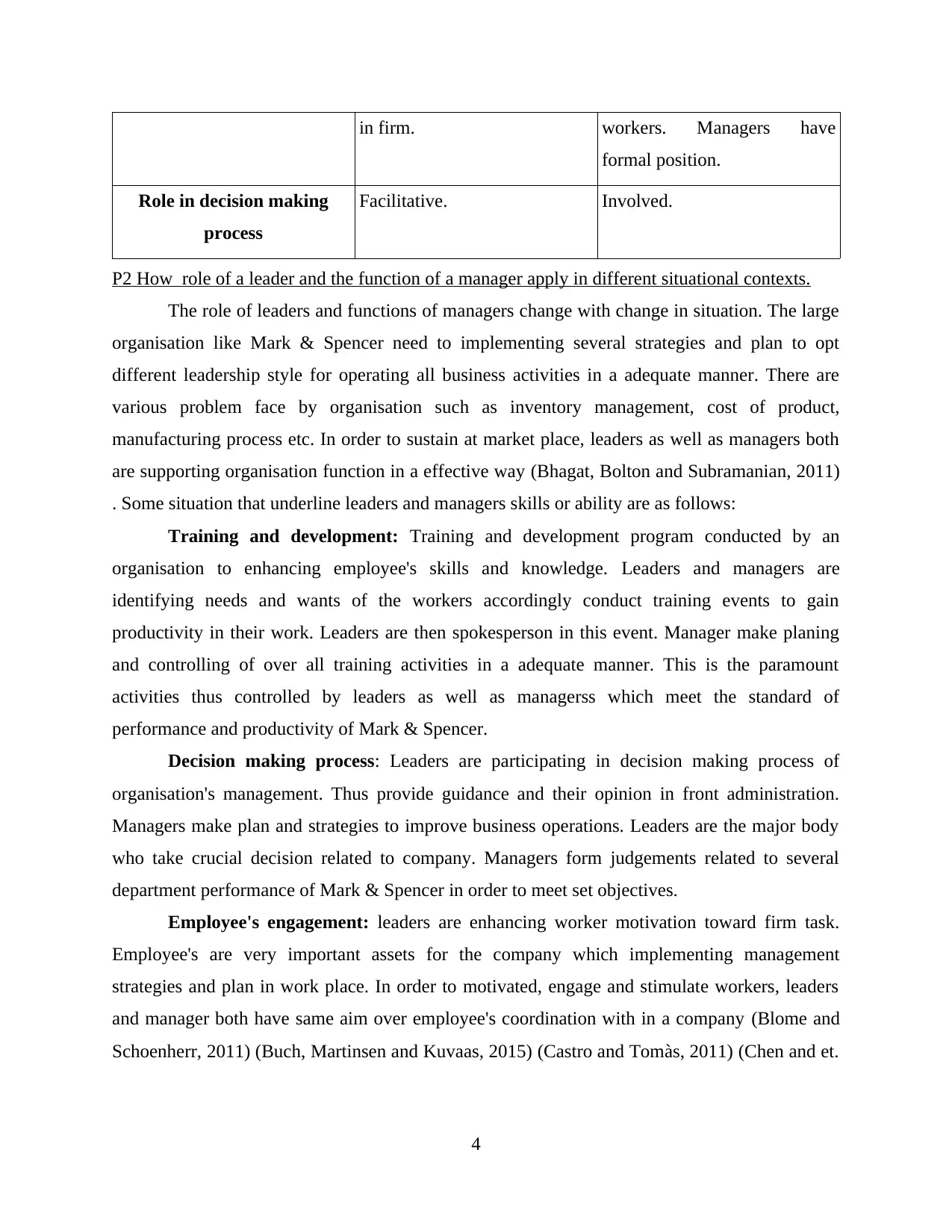
in firm. workers. Managers have
formal position.
Role in decision making
process
Facilitative. Involved.
P2 How role of a leader and the function of a manager apply in different situational contexts.
The role of leaders and functions of managers change with change in situation. The large
organisation like Mark & Spencer need to implementing several strategies and plan to opt
different leadership style for operating all business activities in a adequate manner. There are
various problem face by organisation such as inventory management, cost of product,
manufacturing process etc. In order to sustain at market place, leaders as well as managers both
are supporting organisation function in a effective way (Bhagat, Bolton and Subramanian, 2011)
. Some situation that underline leaders and managers skills or ability are as follows:
Training and development: Training and development program conducted by an
organisation to enhancing employee's skills and knowledge. Leaders and managers are
identifying needs and wants of the workers accordingly conduct training events to gain
productivity in their work. Leaders are then spokesperson in this event. Manager make planing
and controlling of over all training activities in a adequate manner. This is the paramount
activities thus controlled by leaders as well as managerss which meet the standard of
performance and productivity of Mark & Spencer.
Decision making process: Leaders are participating in decision making process of
organisation's management. Thus provide guidance and their opinion in front administration.
Managers make plan and strategies to improve business operations. Leaders are the major body
who take crucial decision related to company. Managers form judgements related to several
department performance of Mark & Spencer in order to meet set objectives.
Employee's engagement: leaders are enhancing worker motivation toward firm task.
Employee's are very important assets for the company which implementing management
strategies and plan in work place. In order to motivated, engage and stimulate workers, leaders
and manager both have same aim over employee's coordination with in a company (Blome and
Schoenherr, 2011) (Buch, Martinsen and Kuvaas, 2015) (Castro and Tomàs, 2011) (Chen and et.
4
formal position.
Role in decision making
process
Facilitative. Involved.
P2 How role of a leader and the function of a manager apply in different situational contexts.
The role of leaders and functions of managers change with change in situation. The large
organisation like Mark & Spencer need to implementing several strategies and plan to opt
different leadership style for operating all business activities in a adequate manner. There are
various problem face by organisation such as inventory management, cost of product,
manufacturing process etc. In order to sustain at market place, leaders as well as managers both
are supporting organisation function in a effective way (Bhagat, Bolton and Subramanian, 2011)
. Some situation that underline leaders and managers skills or ability are as follows:
Training and development: Training and development program conducted by an
organisation to enhancing employee's skills and knowledge. Leaders and managers are
identifying needs and wants of the workers accordingly conduct training events to gain
productivity in their work. Leaders are then spokesperson in this event. Manager make planing
and controlling of over all training activities in a adequate manner. This is the paramount
activities thus controlled by leaders as well as managerss which meet the standard of
performance and productivity of Mark & Spencer.
Decision making process: Leaders are participating in decision making process of
organisation's management. Thus provide guidance and their opinion in front administration.
Managers make plan and strategies to improve business operations. Leaders are the major body
who take crucial decision related to company. Managers form judgements related to several
department performance of Mark & Spencer in order to meet set objectives.
Employee's engagement: leaders are enhancing worker motivation toward firm task.
Employee's are very important assets for the company which implementing management
strategies and plan in work place. In order to motivated, engage and stimulate workers, leaders
and manager both have same aim over employee's coordination with in a company (Blome and
Schoenherr, 2011) (Buch, Martinsen and Kuvaas, 2015) (Castro and Tomàs, 2011) (Chen and et.
4
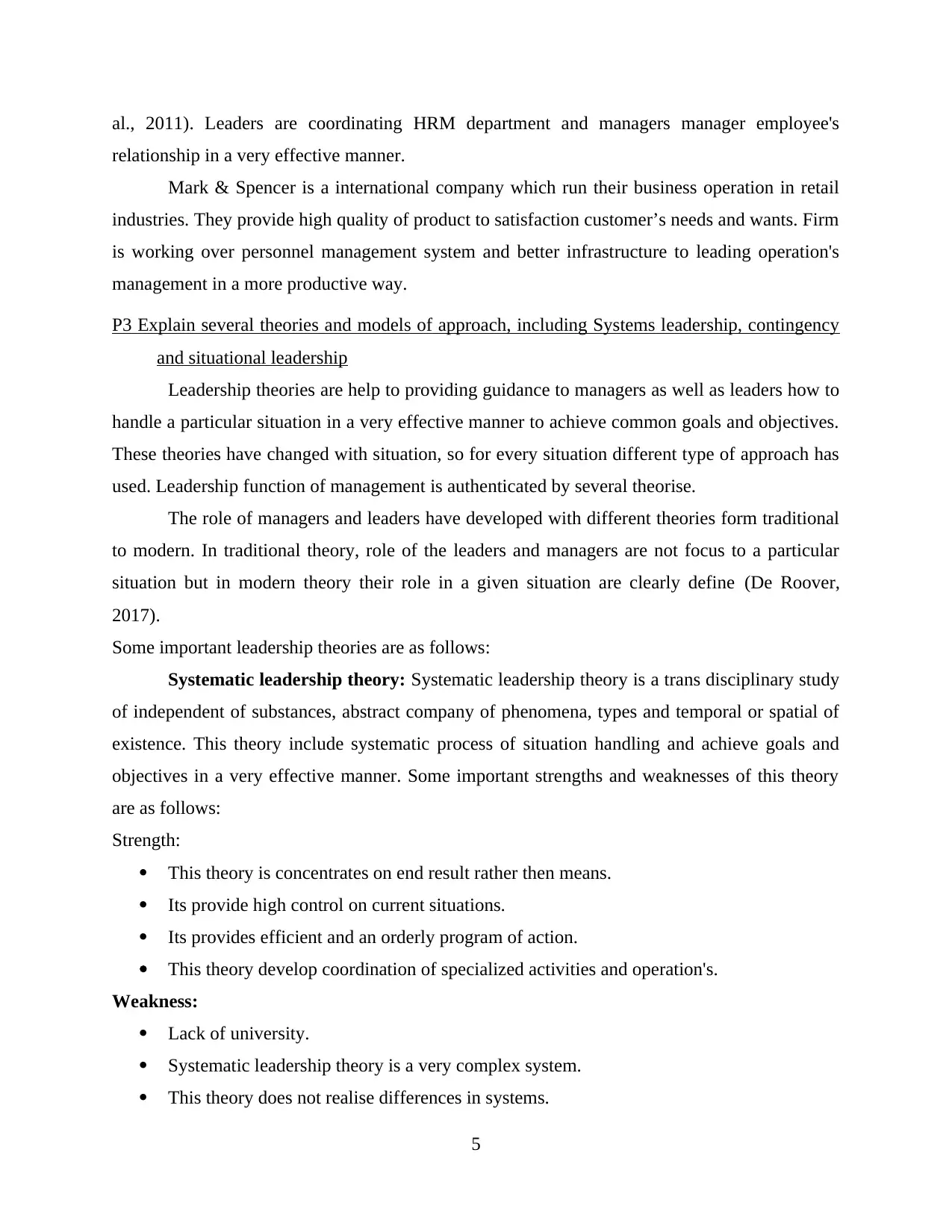
al., 2011). Leaders are coordinating HRM department and managers manager employee's
relationship in a very effective manner.
Mark & Spencer is a international company which run their business operation in retail
industries. They provide high quality of product to satisfaction customer’s needs and wants. Firm
is working over personnel management system and better infrastructure to leading operation's
management in a more productive way.
P3 Explain several theories and models of approach, including Systems leadership, contingency
and situational leadership
Leadership theories are help to providing guidance to managers as well as leaders how to
handle a particular situation in a very effective manner to achieve common goals and objectives.
These theories have changed with situation, so for every situation different type of approach has
used. Leadership function of management is authenticated by several theorise.
The role of managers and leaders have developed with different theories form traditional
to modern. In traditional theory, role of the leaders and managers are not focus to a particular
situation but in modern theory their role in a given situation are clearly define (De Roover,
2017).
Some important leadership theories are as follows:
Systematic leadership theory: Systematic leadership theory is a trans disciplinary study
of independent of substances, abstract company of phenomena, types and temporal or spatial of
existence. This theory include systematic process of situation handling and achieve goals and
objectives in a very effective manner. Some important strengths and weaknesses of this theory
are as follows:
Strength:
This theory is concentrates on end result rather then means.
Its provide high control on current situations.
Its provides efficient and an orderly program of action.
This theory develop coordination of specialized activities and operation's.
Weakness:
Lack of university.
Systematic leadership theory is a very complex system.
This theory does not realise differences in systems.
5
relationship in a very effective manner.
Mark & Spencer is a international company which run their business operation in retail
industries. They provide high quality of product to satisfaction customer’s needs and wants. Firm
is working over personnel management system and better infrastructure to leading operation's
management in a more productive way.
P3 Explain several theories and models of approach, including Systems leadership, contingency
and situational leadership
Leadership theories are help to providing guidance to managers as well as leaders how to
handle a particular situation in a very effective manner to achieve common goals and objectives.
These theories have changed with situation, so for every situation different type of approach has
used. Leadership function of management is authenticated by several theorise.
The role of managers and leaders have developed with different theories form traditional
to modern. In traditional theory, role of the leaders and managers are not focus to a particular
situation but in modern theory their role in a given situation are clearly define (De Roover,
2017).
Some important leadership theories are as follows:
Systematic leadership theory: Systematic leadership theory is a trans disciplinary study
of independent of substances, abstract company of phenomena, types and temporal or spatial of
existence. This theory include systematic process of situation handling and achieve goals and
objectives in a very effective manner. Some important strengths and weaknesses of this theory
are as follows:
Strength:
This theory is concentrates on end result rather then means.
Its provide high control on current situations.
Its provides efficient and an orderly program of action.
This theory develop coordination of specialized activities and operation's.
Weakness:
Lack of university.
Systematic leadership theory is a very complex system.
This theory does not realise differences in systems.
5
⊘ This is a preview!⊘
Do you want full access?
Subscribe today to unlock all pages.

Trusted by 1+ million students worldwide
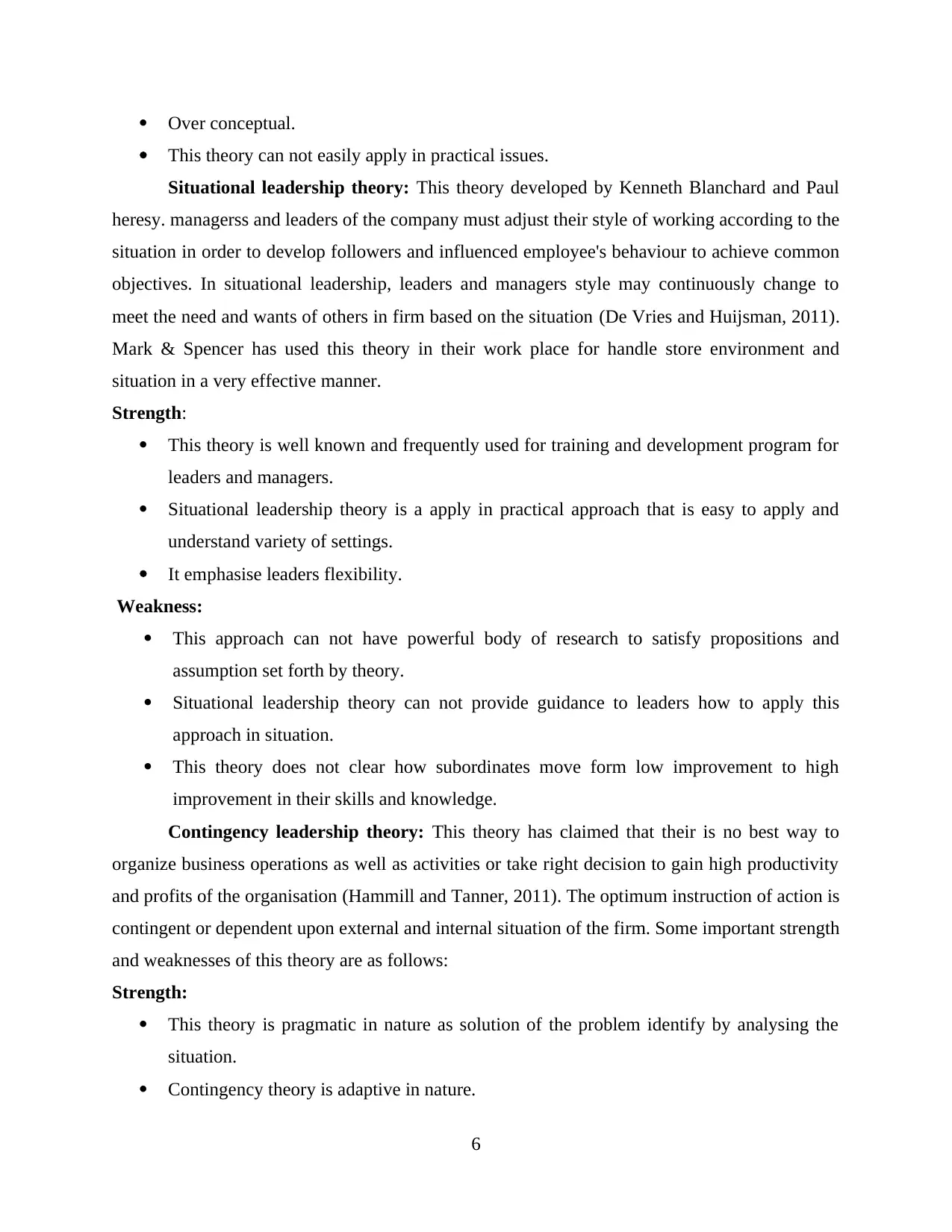
Over conceptual.
This theory can not easily apply in practical issues.
Situational leadership theory: This theory developed by Kenneth Blanchard and Paul
heresy. managerss and leaders of the company must adjust their style of working according to the
situation in order to develop followers and influenced employee's behaviour to achieve common
objectives. In situational leadership, leaders and managers style may continuously change to
meet the need and wants of others in firm based on the situation (De Vries and Huijsman, 2011).
Mark & Spencer has used this theory in their work place for handle store environment and
situation in a very effective manner.
Strength:
This theory is well known and frequently used for training and development program for
leaders and managers.
Situational leadership theory is a apply in practical approach that is easy to apply and
understand variety of settings.
It emphasise leaders flexibility.
Weakness:
This approach can not have powerful body of research to satisfy propositions and
assumption set forth by theory.
Situational leadership theory can not provide guidance to leaders how to apply this
approach in situation.
This theory does not clear how subordinates move form low improvement to high
improvement in their skills and knowledge.
Contingency leadership theory: This theory has claimed that their is no best way to
organize business operations as well as activities or take right decision to gain high productivity
and profits of the organisation (Hammill and Tanner, 2011). The optimum instruction of action is
contingent or dependent upon external and internal situation of the firm. Some important strength
and weaknesses of this theory are as follows:
Strength:
This theory is pragmatic in nature as solution of the problem identify by analysing the
situation.
Contingency theory is adaptive in nature.
6
This theory can not easily apply in practical issues.
Situational leadership theory: This theory developed by Kenneth Blanchard and Paul
heresy. managerss and leaders of the company must adjust their style of working according to the
situation in order to develop followers and influenced employee's behaviour to achieve common
objectives. In situational leadership, leaders and managers style may continuously change to
meet the need and wants of others in firm based on the situation (De Vries and Huijsman, 2011).
Mark & Spencer has used this theory in their work place for handle store environment and
situation in a very effective manner.
Strength:
This theory is well known and frequently used for training and development program for
leaders and managers.
Situational leadership theory is a apply in practical approach that is easy to apply and
understand variety of settings.
It emphasise leaders flexibility.
Weakness:
This approach can not have powerful body of research to satisfy propositions and
assumption set forth by theory.
Situational leadership theory can not provide guidance to leaders how to apply this
approach in situation.
This theory does not clear how subordinates move form low improvement to high
improvement in their skills and knowledge.
Contingency leadership theory: This theory has claimed that their is no best way to
organize business operations as well as activities or take right decision to gain high productivity
and profits of the organisation (Hammill and Tanner, 2011). The optimum instruction of action is
contingent or dependent upon external and internal situation of the firm. Some important strength
and weaknesses of this theory are as follows:
Strength:
This theory is pragmatic in nature as solution of the problem identify by analysing the
situation.
Contingency theory is adaptive in nature.
6
Paraphrase This Document
Need a fresh take? Get an instant paraphrase of this document with our AI Paraphraser
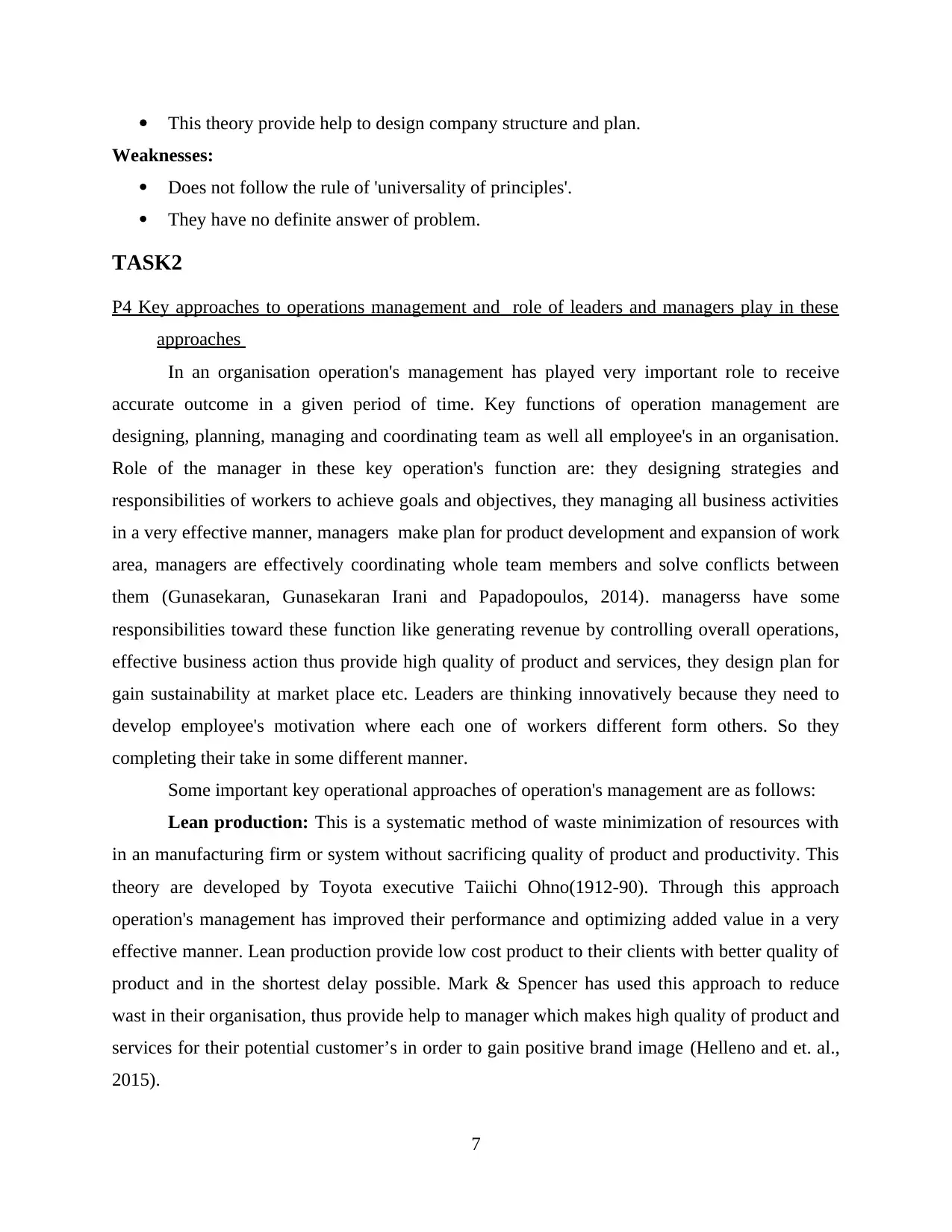
This theory provide help to design company structure and plan.
Weaknesses:
Does not follow the rule of 'universality of principles'.
They have no definite answer of problem.
TASK2
P4 Key approaches to operations management and role of leaders and managers play in these
approaches
In an organisation operation's management has played very important role to receive
accurate outcome in a given period of time. Key functions of operation management are
designing, planning, managing and coordinating team as well all employee's in an organisation.
Role of the manager in these key operation's function are: they designing strategies and
responsibilities of workers to achieve goals and objectives, they managing all business activities
in a very effective manner, managers make plan for product development and expansion of work
area, managers are effectively coordinating whole team members and solve conflicts between
them (Gunasekaran, Gunasekaran Irani and Papadopoulos, 2014). managerss have some
responsibilities toward these function like generating revenue by controlling overall operations,
effective business action thus provide high quality of product and services, they design plan for
gain sustainability at market place etc. Leaders are thinking innovatively because they need to
develop employee's motivation where each one of workers different form others. So they
completing their take in some different manner.
Some important key operational approaches of operation's management are as follows:
Lean production: This is a systematic method of waste minimization of resources with
in an manufacturing firm or system without sacrificing quality of product and productivity. This
theory are developed by Toyota executive Taiichi Ohno(1912-90). Through this approach
operation's management has improved their performance and optimizing added value in a very
effective manner. Lean production provide low cost product to their clients with better quality of
product and in the shortest delay possible. Mark & Spencer has used this approach to reduce
wast in their organisation, thus provide help to manager which makes high quality of product and
services for their potential customer’s in order to gain positive brand image (Helleno and et. al.,
2015).
7
Weaknesses:
Does not follow the rule of 'universality of principles'.
They have no definite answer of problem.
TASK2
P4 Key approaches to operations management and role of leaders and managers play in these
approaches
In an organisation operation's management has played very important role to receive
accurate outcome in a given period of time. Key functions of operation management are
designing, planning, managing and coordinating team as well all employee's in an organisation.
Role of the manager in these key operation's function are: they designing strategies and
responsibilities of workers to achieve goals and objectives, they managing all business activities
in a very effective manner, managers make plan for product development and expansion of work
area, managers are effectively coordinating whole team members and solve conflicts between
them (Gunasekaran, Gunasekaran Irani and Papadopoulos, 2014). managerss have some
responsibilities toward these function like generating revenue by controlling overall operations,
effective business action thus provide high quality of product and services, they design plan for
gain sustainability at market place etc. Leaders are thinking innovatively because they need to
develop employee's motivation where each one of workers different form others. So they
completing their take in some different manner.
Some important key operational approaches of operation's management are as follows:
Lean production: This is a systematic method of waste minimization of resources with
in an manufacturing firm or system without sacrificing quality of product and productivity. This
theory are developed by Toyota executive Taiichi Ohno(1912-90). Through this approach
operation's management has improved their performance and optimizing added value in a very
effective manner. Lean production provide low cost product to their clients with better quality of
product and in the shortest delay possible. Mark & Spencer has used this approach to reduce
wast in their organisation, thus provide help to manager which makes high quality of product and
services for their potential customer’s in order to gain positive brand image (Helleno and et. al.,
2015).
7
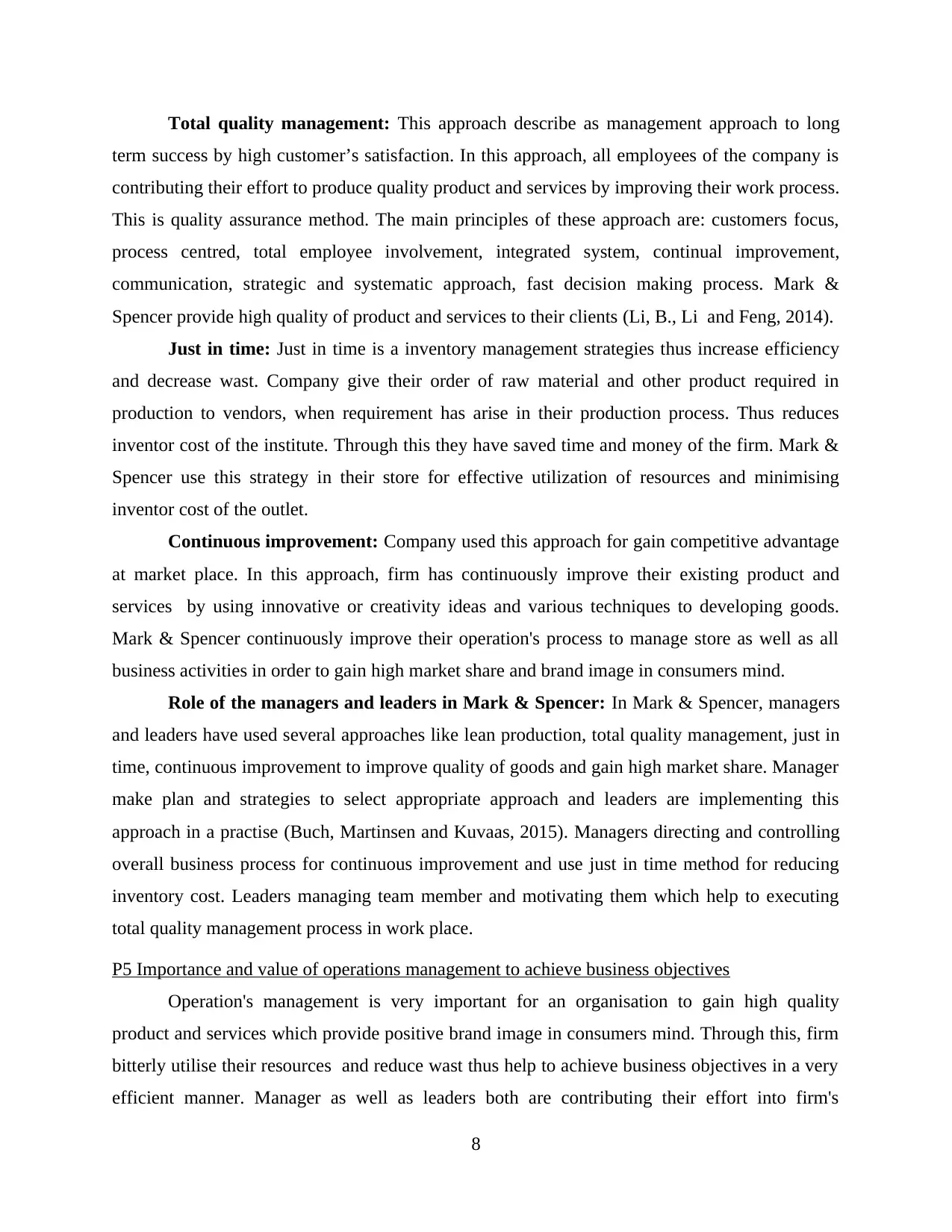
Total quality management: This approach describe as management approach to long
term success by high customer’s satisfaction. In this approach, all employees of the company is
contributing their effort to produce quality product and services by improving their work process.
This is quality assurance method. The main principles of these approach are: customers focus,
process centred, total employee involvement, integrated system, continual improvement,
communication, strategic and systematic approach, fast decision making process. Mark &
Spencer provide high quality of product and services to their clients (Li, B., Li and Feng, 2014).
Just in time: Just in time is a inventory management strategies thus increase efficiency
and decrease wast. Company give their order of raw material and other product required in
production to vendors, when requirement has arise in their production process. Thus reduces
inventor cost of the institute. Through this they have saved time and money of the firm. Mark &
Spencer use this strategy in their store for effective utilization of resources and minimising
inventor cost of the outlet.
Continuous improvement: Company used this approach for gain competitive advantage
at market place. In this approach, firm has continuously improve their existing product and
services by using innovative or creativity ideas and various techniques to developing goods.
Mark & Spencer continuously improve their operation's process to manage store as well as all
business activities in order to gain high market share and brand image in consumers mind.
Role of the managers and leaders in Mark & Spencer: In Mark & Spencer, managers
and leaders have used several approaches like lean production, total quality management, just in
time, continuous improvement to improve quality of goods and gain high market share. Manager
make plan and strategies to select appropriate approach and leaders are implementing this
approach in a practise (Buch, Martinsen and Kuvaas, 2015). Managers directing and controlling
overall business process for continuous improvement and use just in time method for reducing
inventory cost. Leaders managing team member and motivating them which help to executing
total quality management process in work place.
P5 Importance and value of operations management to achieve business objectives
Operation's management is very important for an organisation to gain high quality
product and services which provide positive brand image in consumers mind. Through this, firm
bitterly utilise their resources and reduce wast thus help to achieve business objectives in a very
efficient manner. Manager as well as leaders both are contributing their effort into firm's
8
term success by high customer’s satisfaction. In this approach, all employees of the company is
contributing their effort to produce quality product and services by improving their work process.
This is quality assurance method. The main principles of these approach are: customers focus,
process centred, total employee involvement, integrated system, continual improvement,
communication, strategic and systematic approach, fast decision making process. Mark &
Spencer provide high quality of product and services to their clients (Li, B., Li and Feng, 2014).
Just in time: Just in time is a inventory management strategies thus increase efficiency
and decrease wast. Company give their order of raw material and other product required in
production to vendors, when requirement has arise in their production process. Thus reduces
inventor cost of the institute. Through this they have saved time and money of the firm. Mark &
Spencer use this strategy in their store for effective utilization of resources and minimising
inventor cost of the outlet.
Continuous improvement: Company used this approach for gain competitive advantage
at market place. In this approach, firm has continuously improve their existing product and
services by using innovative or creativity ideas and various techniques to developing goods.
Mark & Spencer continuously improve their operation's process to manage store as well as all
business activities in order to gain high market share and brand image in consumers mind.
Role of the managers and leaders in Mark & Spencer: In Mark & Spencer, managers
and leaders have used several approaches like lean production, total quality management, just in
time, continuous improvement to improve quality of goods and gain high market share. Manager
make plan and strategies to select appropriate approach and leaders are implementing this
approach in a practise (Buch, Martinsen and Kuvaas, 2015). Managers directing and controlling
overall business process for continuous improvement and use just in time method for reducing
inventory cost. Leaders managing team member and motivating them which help to executing
total quality management process in work place.
P5 Importance and value of operations management to achieve business objectives
Operation's management is very important for an organisation to gain high quality
product and services which provide positive brand image in consumers mind. Through this, firm
bitterly utilise their resources and reduce wast thus help to achieve business objectives in a very
efficient manner. Manager as well as leaders both are contributing their effort into firm's
8
⊘ This is a preview!⊘
Do you want full access?
Subscribe today to unlock all pages.

Trusted by 1+ million students worldwide
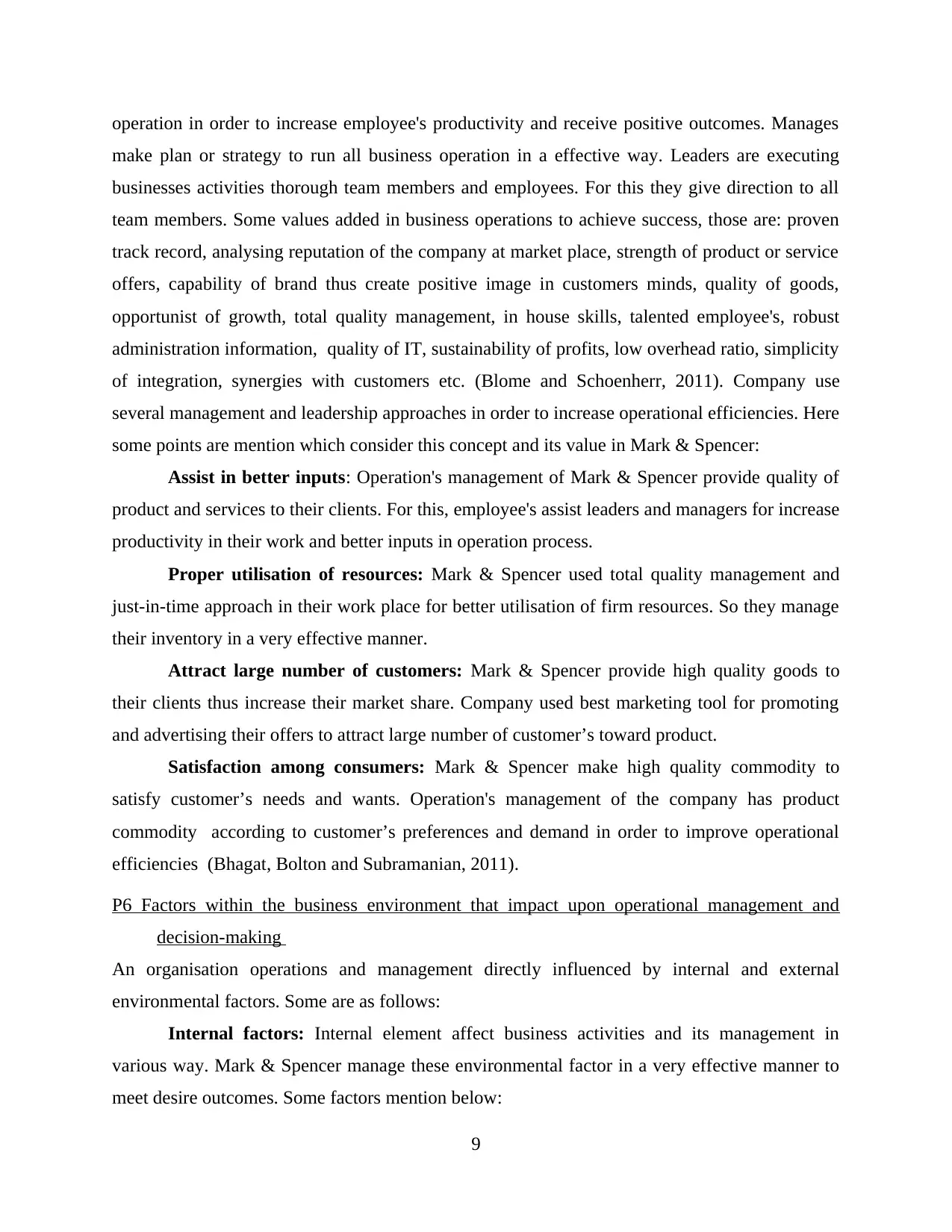
operation in order to increase employee's productivity and receive positive outcomes. Manages
make plan or strategy to run all business operation in a effective way. Leaders are executing
businesses activities thorough team members and employees. For this they give direction to all
team members. Some values added in business operations to achieve success, those are: proven
track record, analysing reputation of the company at market place, strength of product or service
offers, capability of brand thus create positive image in customers minds, quality of goods,
opportunist of growth, total quality management, in house skills, talented employee's, robust
administration information, quality of IT, sustainability of profits, low overhead ratio, simplicity
of integration, synergies with customers etc. (Blome and Schoenherr, 2011). Company use
several management and leadership approaches in order to increase operational efficiencies. Here
some points are mention which consider this concept and its value in Mark & Spencer:
Assist in better inputs: Operation's management of Mark & Spencer provide quality of
product and services to their clients. For this, employee's assist leaders and managers for increase
productivity in their work and better inputs in operation process.
Proper utilisation of resources: Mark & Spencer used total quality management and
just-in-time approach in their work place for better utilisation of firm resources. So they manage
their inventory in a very effective manner.
Attract large number of customers: Mark & Spencer provide high quality goods to
their clients thus increase their market share. Company used best marketing tool for promoting
and advertising their offers to attract large number of customer’s toward product.
Satisfaction among consumers: Mark & Spencer make high quality commodity to
satisfy customer’s needs and wants. Operation's management of the company has product
commodity according to customer’s preferences and demand in order to improve operational
efficiencies (Bhagat, Bolton and Subramanian, 2011).
P6 Factors within the business environment that impact upon operational management and
decision-making
An organisation operations and management directly influenced by internal and external
environmental factors. Some are as follows:
Internal factors: Internal element affect business activities and its management in
various way. Mark & Spencer manage these environmental factor in a very effective manner to
meet desire outcomes. Some factors mention below:
9
make plan or strategy to run all business operation in a effective way. Leaders are executing
businesses activities thorough team members and employees. For this they give direction to all
team members. Some values added in business operations to achieve success, those are: proven
track record, analysing reputation of the company at market place, strength of product or service
offers, capability of brand thus create positive image in customers minds, quality of goods,
opportunist of growth, total quality management, in house skills, talented employee's, robust
administration information, quality of IT, sustainability of profits, low overhead ratio, simplicity
of integration, synergies with customers etc. (Blome and Schoenherr, 2011). Company use
several management and leadership approaches in order to increase operational efficiencies. Here
some points are mention which consider this concept and its value in Mark & Spencer:
Assist in better inputs: Operation's management of Mark & Spencer provide quality of
product and services to their clients. For this, employee's assist leaders and managers for increase
productivity in their work and better inputs in operation process.
Proper utilisation of resources: Mark & Spencer used total quality management and
just-in-time approach in their work place for better utilisation of firm resources. So they manage
their inventory in a very effective manner.
Attract large number of customers: Mark & Spencer provide high quality goods to
their clients thus increase their market share. Company used best marketing tool for promoting
and advertising their offers to attract large number of customer’s toward product.
Satisfaction among consumers: Mark & Spencer make high quality commodity to
satisfy customer’s needs and wants. Operation's management of the company has product
commodity according to customer’s preferences and demand in order to improve operational
efficiencies (Bhagat, Bolton and Subramanian, 2011).
P6 Factors within the business environment that impact upon operational management and
decision-making
An organisation operations and management directly influenced by internal and external
environmental factors. Some are as follows:
Internal factors: Internal element affect business activities and its management in
various way. Mark & Spencer manage these environmental factor in a very effective manner to
meet desire outcomes. Some factors mention below:
9
Paraphrase This Document
Need a fresh take? Get an instant paraphrase of this document with our AI Paraphraser
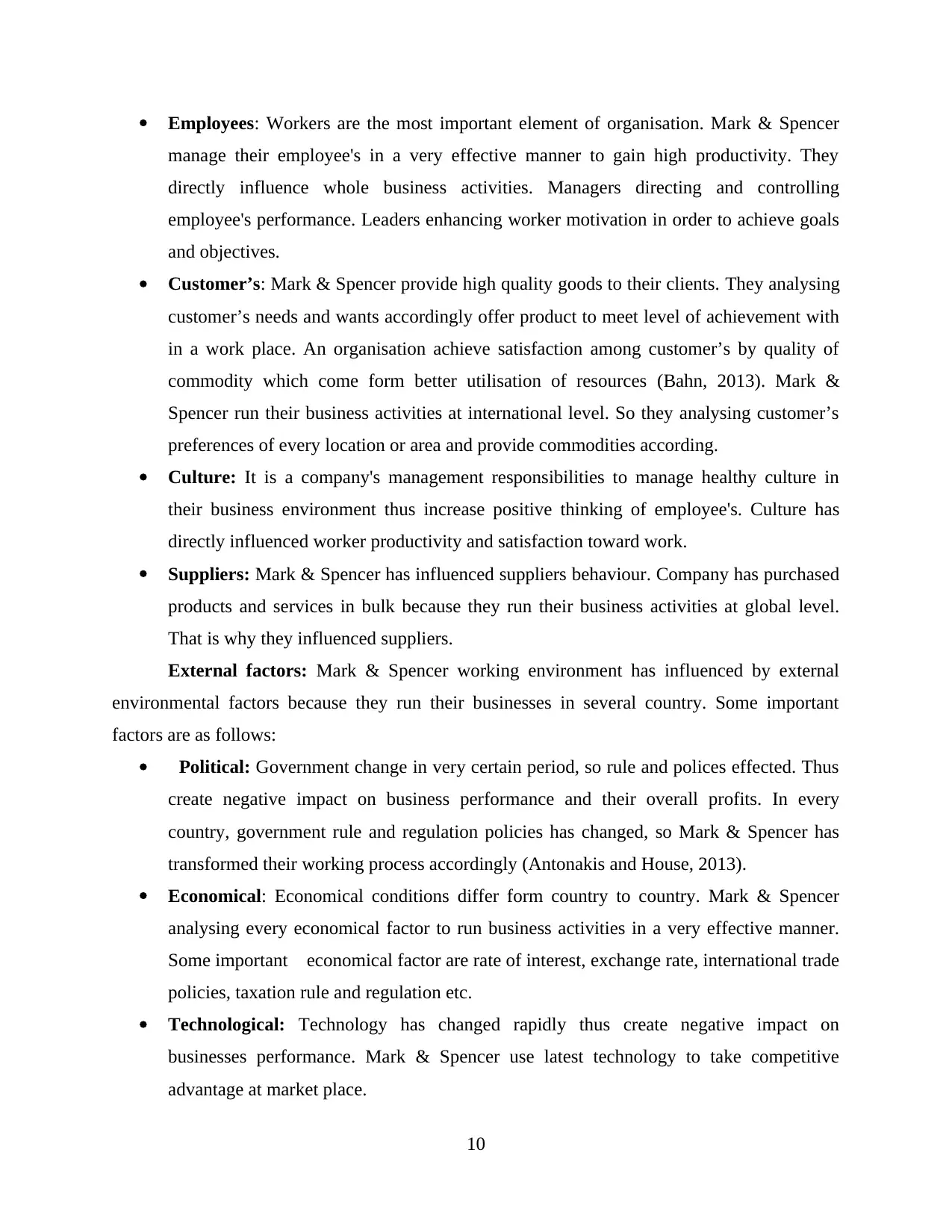
Employees: Workers are the most important element of organisation. Mark & Spencer
manage their employee's in a very effective manner to gain high productivity. They
directly influence whole business activities. Managers directing and controlling
employee's performance. Leaders enhancing worker motivation in order to achieve goals
and objectives.
Customer’s: Mark & Spencer provide high quality goods to their clients. They analysing
customer’s needs and wants accordingly offer product to meet level of achievement with
in a work place. An organisation achieve satisfaction among customer’s by quality of
commodity which come form better utilisation of resources (Bahn, 2013). Mark &
Spencer run their business activities at international level. So they analysing customer’s
preferences of every location or area and provide commodities according.
Culture: It is a company's management responsibilities to manage healthy culture in
their business environment thus increase positive thinking of employee's. Culture has
directly influenced worker productivity and satisfaction toward work.
Suppliers: Mark & Spencer has influenced suppliers behaviour. Company has purchased
products and services in bulk because they run their business activities at global level.
That is why they influenced suppliers.
External factors: Mark & Spencer working environment has influenced by external
environmental factors because they run their businesses in several country. Some important
factors are as follows:
Political: Government change in very certain period, so rule and polices effected. Thus
create negative impact on business performance and their overall profits. In every
country, government rule and regulation policies has changed, so Mark & Spencer has
transformed their working process accordingly (Antonakis and House, 2013).
Economical: Economical conditions differ form country to country. Mark & Spencer
analysing every economical factor to run business activities in a very effective manner.
Some important economical factor are rate of interest, exchange rate, international trade
policies, taxation rule and regulation etc.
Technological: Technology has changed rapidly thus create negative impact on
businesses performance. Mark & Spencer use latest technology to take competitive
advantage at market place.
10
manage their employee's in a very effective manner to gain high productivity. They
directly influence whole business activities. Managers directing and controlling
employee's performance. Leaders enhancing worker motivation in order to achieve goals
and objectives.
Customer’s: Mark & Spencer provide high quality goods to their clients. They analysing
customer’s needs and wants accordingly offer product to meet level of achievement with
in a work place. An organisation achieve satisfaction among customer’s by quality of
commodity which come form better utilisation of resources (Bahn, 2013). Mark &
Spencer run their business activities at international level. So they analysing customer’s
preferences of every location or area and provide commodities according.
Culture: It is a company's management responsibilities to manage healthy culture in
their business environment thus increase positive thinking of employee's. Culture has
directly influenced worker productivity and satisfaction toward work.
Suppliers: Mark & Spencer has influenced suppliers behaviour. Company has purchased
products and services in bulk because they run their business activities at global level.
That is why they influenced suppliers.
External factors: Mark & Spencer working environment has influenced by external
environmental factors because they run their businesses in several country. Some important
factors are as follows:
Political: Government change in very certain period, so rule and polices effected. Thus
create negative impact on business performance and their overall profits. In every
country, government rule and regulation policies has changed, so Mark & Spencer has
transformed their working process accordingly (Antonakis and House, 2013).
Economical: Economical conditions differ form country to country. Mark & Spencer
analysing every economical factor to run business activities in a very effective manner.
Some important economical factor are rate of interest, exchange rate, international trade
policies, taxation rule and regulation etc.
Technological: Technology has changed rapidly thus create negative impact on
businesses performance. Mark & Spencer use latest technology to take competitive
advantage at market place.
10
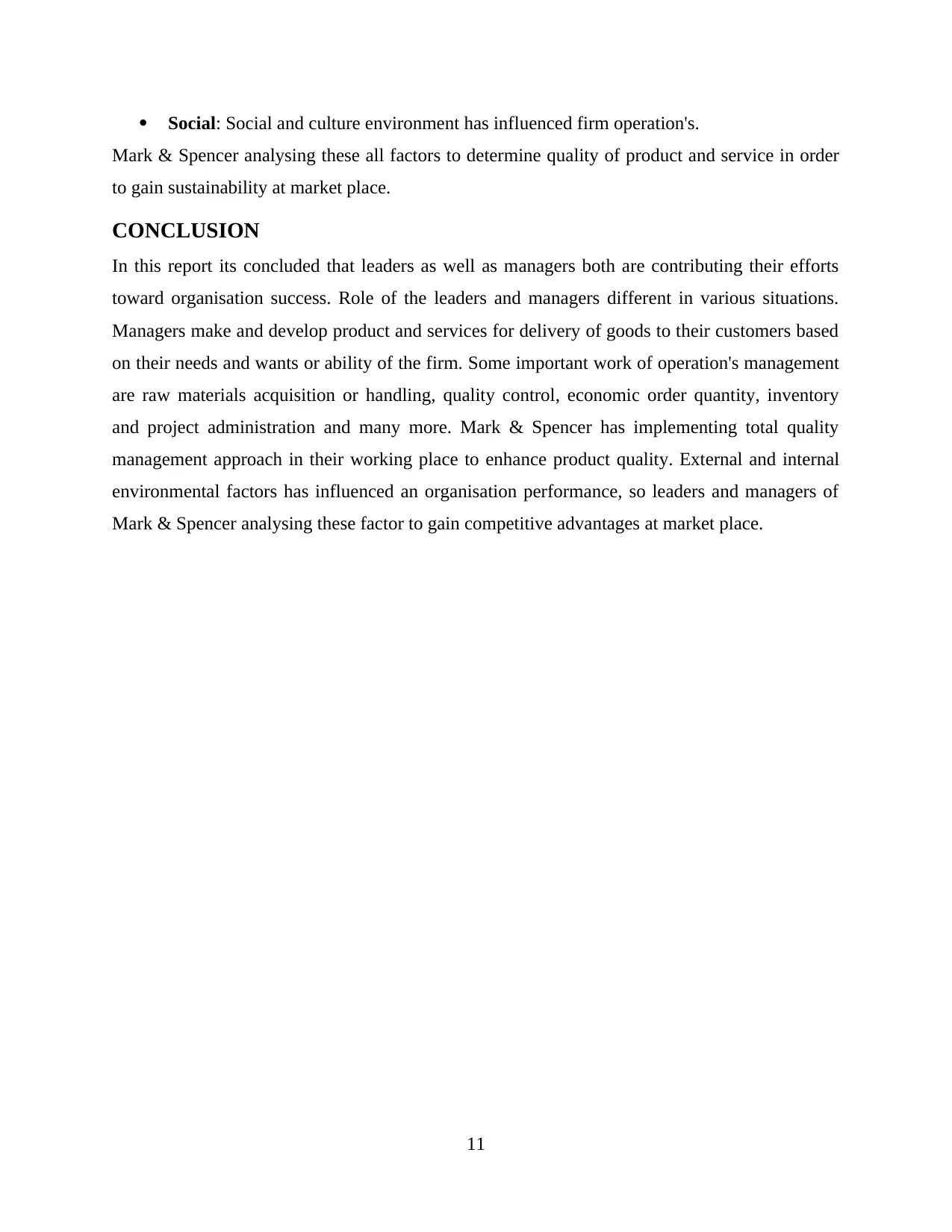
Social: Social and culture environment has influenced firm operation's.
Mark & Spencer analysing these all factors to determine quality of product and service in order
to gain sustainability at market place.
CONCLUSION
In this report its concluded that leaders as well as managers both are contributing their efforts
toward organisation success. Role of the leaders and managers different in various situations.
Managers make and develop product and services for delivery of goods to their customers based
on their needs and wants or ability of the firm. Some important work of operation's management
are raw materials acquisition or handling, quality control, economic order quantity, inventory
and project administration and many more. Mark & Spencer has implementing total quality
management approach in their working place to enhance product quality. External and internal
environmental factors has influenced an organisation performance, so leaders and managers of
Mark & Spencer analysing these factor to gain competitive advantages at market place.
11
Mark & Spencer analysing these all factors to determine quality of product and service in order
to gain sustainability at market place.
CONCLUSION
In this report its concluded that leaders as well as managers both are contributing their efforts
toward organisation success. Role of the leaders and managers different in various situations.
Managers make and develop product and services for delivery of goods to their customers based
on their needs and wants or ability of the firm. Some important work of operation's management
are raw materials acquisition or handling, quality control, economic order quantity, inventory
and project administration and many more. Mark & Spencer has implementing total quality
management approach in their working place to enhance product quality. External and internal
environmental factors has influenced an organisation performance, so leaders and managers of
Mark & Spencer analysing these factor to gain competitive advantages at market place.
11
⊘ This is a preview!⊘
Do you want full access?
Subscribe today to unlock all pages.

Trusted by 1+ million students worldwide
1 out of 13
Related Documents
Your All-in-One AI-Powered Toolkit for Academic Success.
+13062052269
info@desklib.com
Available 24*7 on WhatsApp / Email
![[object Object]](/_next/static/media/star-bottom.7253800d.svg)
Unlock your academic potential
Copyright © 2020–2025 A2Z Services. All Rights Reserved. Developed and managed by ZUCOL.





